Influence of valine and other amino acids on total diacetyl and 2,3-pentanedione levels during fermentation of brewer's wort
- PMID: 23677441
- PMCID: PMC3708283
- DOI: 10.1007/s00253-013-4955-1
Influence of valine and other amino acids on total diacetyl and 2,3-pentanedione levels during fermentation of brewer's wort
Abstract
Undesirable butter-tasting vicinal diketones are produced as by-products of valine and isoleucine biosynthesis during wort fermentation. One promising method of decreasing diacetyl production is through control of wort valine content since valine is involved in feedback inhibition of enzymes controlling the formation of diacetyl precursors. Here, the influence of valine supplementation, wort amino acid profile and free amino nitrogen content on diacetyl formation during wort fermentation with the lager yeast Saccharomyces pastorianus was investigated. Valine supplementation (100 to 300 mg L(-1)) resulted in decreased maximum diacetyl concentrations (up to 37 % lower) and diacetyl concentrations at the end of fermentation (up to 33 % lower) in all trials. Composition of the amino acid spectrum of the wort also had an impact on diacetyl and 2,3-pentanedione production during fermentation. No direct correlation between the wort amino acid concentrations and diacetyl production was found, but rather a negative correlation between the uptake rate of valine (and also other branched-chain amino acids) and diacetyl production. Fermentation performance and yeast growth were unaffected by supplementations. Amino acid addition had a minor effect on higher alcohol and ester composition, suggesting that high levels of supplementation could affect the flavour profile of the beer. Modifying amino acid profile of wort, especially with respect to valine and the other branched-chain amino acids, may be an effective way of decreasing the amount of diacetyl formed during fermentation.
Figures
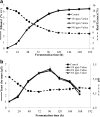
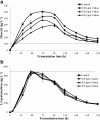
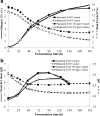
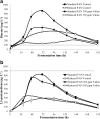


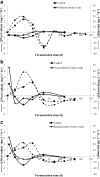
Similar articles
-
Construction of self-cloning bottom-fermenting yeast with low vicinal diketone production by the homo-integration of ILV5.Yeast. 2012 Oct;29(10):435-42. doi: 10.1002/yea.2922. Epub 2012 Oct 5. Yeast. 2012. PMID: 23038161
-
Peptide (Lys-Leu) and amino acids (Lys and Leu) supplementations improve physiological activity and fermentation performance of brewer's yeast during very high-gravity (VHG) wort fermentation.Biotechnol Appl Biochem. 2018 Jul;65(4):630-638. doi: 10.1002/bab.1634. Epub 2018 Jan 16. Biotechnol Appl Biochem. 2018. PMID: 29271090
-
Variation in α-acetolactate production within the hybrid lager yeast group Saccharomyces pastorianus and affirmation of the central role of the ILV6 gene.Yeast. 2015 Jan;32(1):301-16. doi: 10.1002/yea.3026. Epub 2014 Aug 6. Yeast. 2015. PMID: 24965182
-
Diacetyl formation by lactic bacteria.Rev Latinoam Microbiol. 1996 Apr-Jun;38(2):129-37. Rev Latinoam Microbiol. 1996. PMID: 8986113 Review.
-
Review of evidence relating to occupational exposure limits for alpha-diketones and acetoin, and considerations for deriving an occupational exposure limit for 2,3-pentanedione.Crit Rev Toxicol. 2022 Oct;52(9):715-730. doi: 10.1080/10408444.2023.2168175. Epub 2023 Feb 21. Crit Rev Toxicol. 2022. PMID: 36803409 Review.
Cited by
-
Diacetyl control during brewery fermentation via adaptive laboratory engineering of the lager yeast Saccharomyces pastorianus.J Ind Microbiol Biotechnol. 2018 Dec;45(12):1103-1112. doi: 10.1007/s10295-018-2087-4. Epub 2018 Oct 10. J Ind Microbiol Biotechnol. 2018. PMID: 30306366 Free PMC article.
-
Comprehensive Real-Time Analysis of the Yeast Volatilome.Sci Rep. 2017 Oct 27;7(1):14236. doi: 10.1038/s41598-017-14554-y. Sci Rep. 2017. PMID: 29079837 Free PMC article.
-
Analysis of the bacterial and fungal populations in South African sorghum beer (umqombothi) using full-length 16S rRNA amplicon sequencing.World J Microbiol Biotechnol. 2023 Oct 21;39(12):350. doi: 10.1007/s11274-023-03764-4. World J Microbiol Biotechnol. 2023. PMID: 37864040 Free PMC article.
-
Plasticity of gene expression in the nervous system by exposure to environmental odorants that inhibit HDACs.Elife. 2024 Feb 27;12:RP86823. doi: 10.7554/eLife.86823. Elife. 2024. PMID: 38411140 Free PMC article.
-
Assessing Population Diversity of Brettanomyces Yeast Species and Identification of Strains for Brewing Applications.Front Microbiol. 2020 Apr 9;11:637. doi: 10.3389/fmicb.2020.00637. eCollection 2020. Front Microbiol. 2020. PMID: 32373090 Free PMC article.
References
-
- Bamforth CW, Kanauchi M. Enzymology of vicinal diketone reduction in brewer’s yeast. J Inst Brew. 2004;110:83–93. doi: 10.1002/j.2050-0416.2004.tb00187.x. - DOI
-
- Barton S, Slaughter J. Amino acids and vicinal diketone concentrations during fermentation. Technol Quart MBAA. 1992;29:60–63.
-
- Boulton C, Quain D, (2001) Brewing yeast and fermentation. Blackwell
MeSH terms
Substances
LinkOut - more resources
Full Text Sources
Other Literature Sources
Molecular Biology Databases

